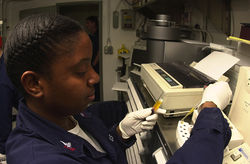Serum (blood)
 From Wikipedia - Reading time: 7 min
From Wikipedia - Reading time: 7 min

Serum (/ˈsɪərəm/) is the fluid and solvent component of blood which does not play a role in clotting.[1] It may be defined as blood plasma without the clotting factors, or as blood with all cells and clotting factors removed. Serum contains all proteins except clotting factors (involved in blood clotting), including all electrolytes, antibodies, antigens, hormones; and any exogenous substances (e.g., drugs, microorganisms). Serum also does not contain all the formed elements of blood, which include blood cells, white blood cells (leukocytes, lymphocytes), red blood cells (erythrocytes), and platelets.[citation needed]
The study of serum is serology. Serum is used in numerous diagnostic tests as well as blood typing. Measuring the concentration of various molecules can be useful for many applications, such as determining the therapeutic index of a drug candidate in a clinical trial.[2]
To obtain serum, a blood sample is allowed to clot (coagulation). The sample is then centrifuged to remove the clot and blood cells, and the resulting liquid supernatant is serum.[3]
Clinical and laboratory uses
[edit]The serum of convalescent patients successfully recovering (or already recovered) from an infectious disease can be used as a biopharmaceutical in the treatment of other people with that disease, because the antibodies generated by the successful recovery are potent fighters of the pathogen. Such convalescent serum (antiserum) is a form of immunotherapy.[citation needed]
Serum is also used in protein electrophoresis, due to the lack of fibrinogen which can cause false results.[citation needed]
Fetal bovine serum (FBS) is rich in growth factors and is frequently added to growth media used for eukaryotic cell culture. A combination of FBS and the cytokine leukemia inhibitory factor was originally used to maintain embryonic stem cells,[4] but concerns about batch-to-batch variations in FBS have led to the development of serum substitutes.[5]
Purification strategies
[edit]Blood serum and plasma are some of the largest sources of biomarkers, whether for diagnostics or therapeutics. Its vast dynamic range, further complicated by the presence of lipids, salts, and post-translational modifications, as well as multiple mechanisms of degradation, presents challenges in analytical reproducibility, sensitivity, resolution, and potential efficacy. For analysis of biomarkers in blood serum samples, it is possible to do a pre-separation by free-flow electrophoresis that usually consists of a depletion of serum albumin protein.[6] This method enables greater penetration of the proteome via separation of a wide variety of charged or chargeable analytes, ranging from small molecules to cells.[citation needed]
Usage note
[edit]Like many other mass nouns, the word serum can be pluralized when used in certain senses. To speak of multiple serum specimens from multiple people (each with a unique population of antibodies), physicians sometimes speak of sera (the Latin plural, as opposed to serums).[citation needed] Etymologically serum is derived from the Proto-Indo-European *ser- ("to flow, run").
See also
[edit]References
[edit]- Martin, Elizabeth A., ed. (2007). Concise Medical Dictionary (7th ed.). Oxford, England: Oxford University Press. ISBN 978-0-19-280697-0. Retrieved 8 September 2009.
- Wang, Wendy; Srivastava, Sudhir (2002). "Serological Markers". In Lester Breslow (ed.). Encyclopedia of Public Health. Vol. 4. New York, New York: Macmillan Reference USA. pp. 1088–1090.
- ^ "serum". The Free Dictionary. Retrieved 2019-10-06.
- ^ Kaplan L (2005-10-06). "Serum Toxicology" (PDF). Clinical Pathology/Laboratory Medicine 2005. Columbia University. Retrieved 2020-01-28.
- ^ Thavasu PW, Longhurst S, Joel SP, Slevin ML, Balkwill FR (August 1992). "Measuring cytokine levels in blood. Importance of anticoagulants, processing, and storage conditions". Journal of Immunological Methods. 153 (1–2): 115–24. doi:10.1016/0022-1759(92)90313-i. PMID 1381403.
- ^ Thomson JA, Itskovitz-Eldor J, Shapiro SS, Waknitz MA, Swiergiel JJ, Marshall VS, Jones JM (6 November 1998). "Embryonic Stem Cell Lines Derived from Human Blastocysts". Science. 282 (5391): 1145–7. Bibcode:1998Sci...282.1145T. doi:10.1126/science.282.5391.1145. PMID 9804556.
- ^ Lee JE, Lee DR (June 2011). "Human embryonic stem cells: derivation, maintenance and cryopreservation". International Journal of Stem Cells. 4 (1): 9–17. doi:10.15283/ijsc.2011.4.1.9. PMC 3840968. PMID 24298329.
- ^ Nissum M, Foucher AL (August 2008). "Analysis of human plasma proteins: a focus on sample collection and separation using free-flow electrophoresis". Expert Review of Proteomics. 5 (4): 571–87. doi:10.1586/14789450.5.4.571. PMID 18761468. S2CID 207200988.
 KSF
KSF